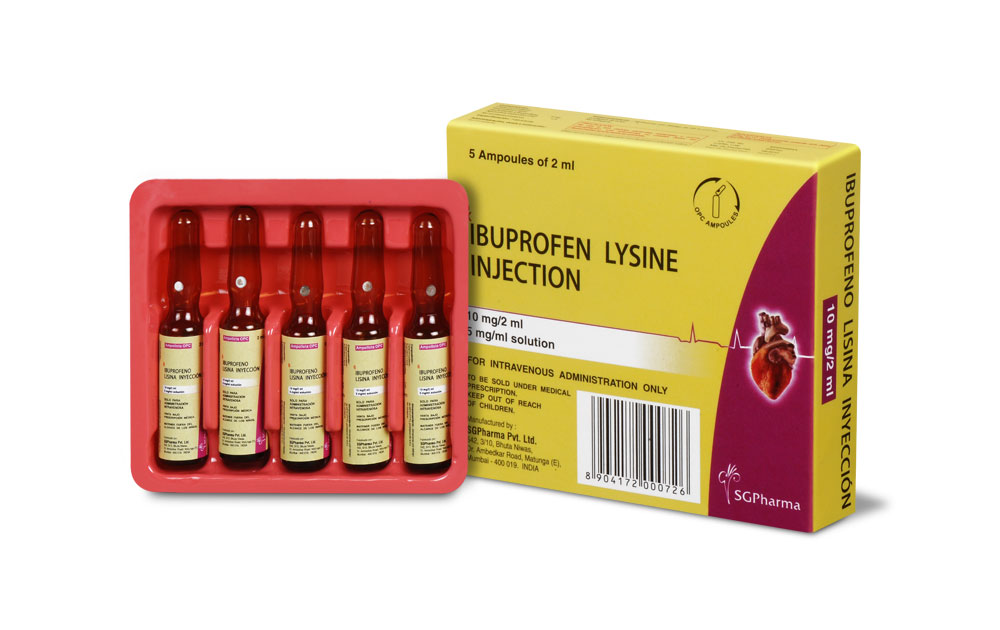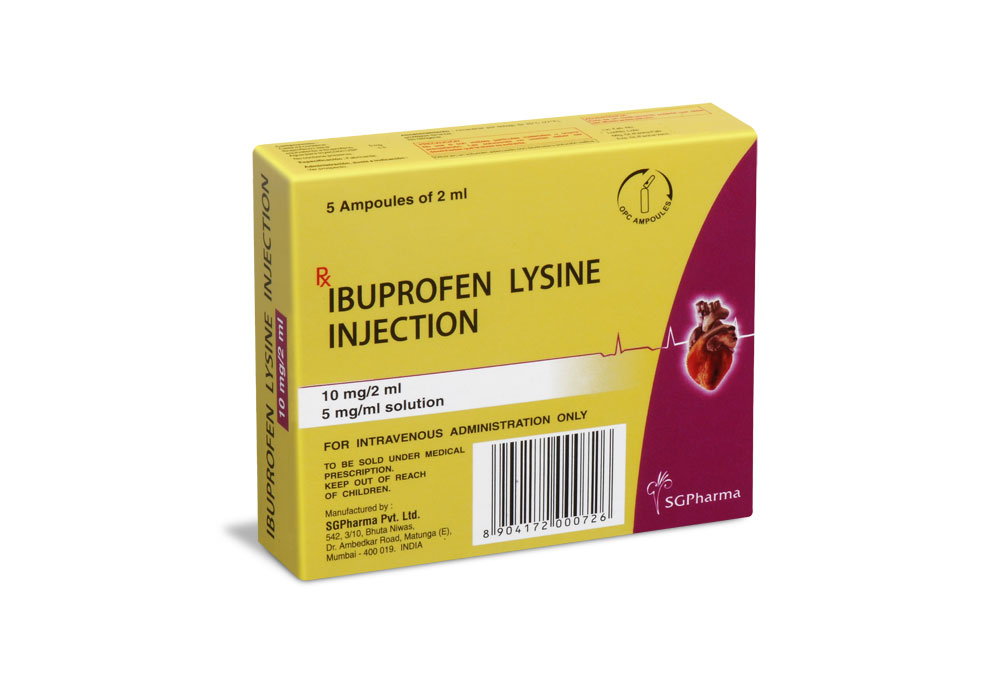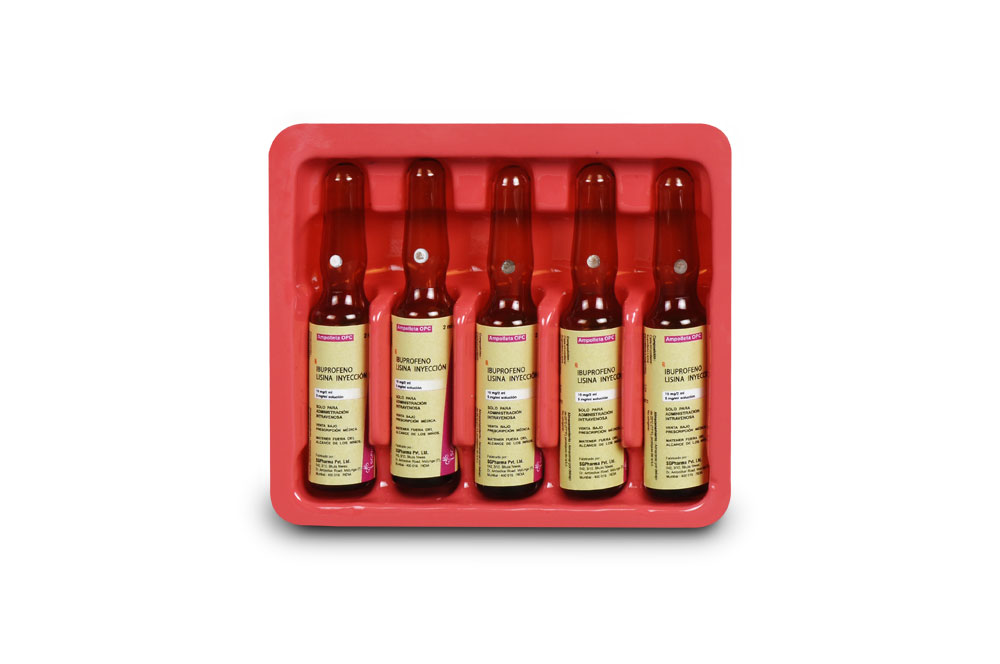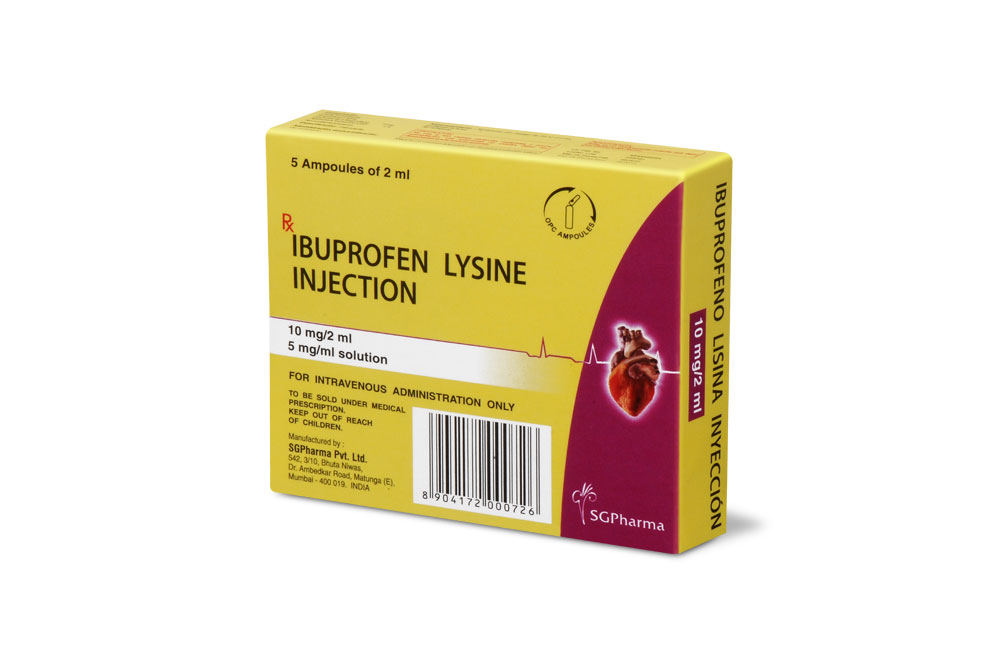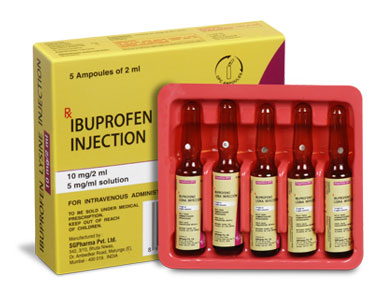
10 mg/2 ml, 20 mg/2 ml
For the use of a Registered Medical Practitioner or a Hospital or a Institution only.
IBUPROFEN INJECTION is a non-steroidal anti-inflammatory drug (NSAID). Chemically, IBUPROFEN is (±)-2-(p-Isobutylphenyl)propionic acid. The molecular formula is C13H18O2 and molecular weight is 206.28.
STRUCTURAL FORMULA :
Its structural formula is :
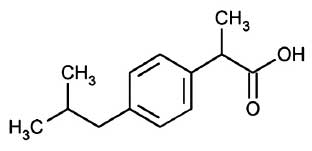
IBUPROFEN INJECTION is a clear, colourless to pale yellow, sterile solution filled in amber tubular vial of suitable size.
COMPOSITION :
Each ml contains :
Ibuprofen USP 100 mg
Water for Injection USP q.s.
ACTIONS :
Ibuprofen is a non-steroidal anti-inflammatory drug (NSAID) that possesses anti-inflammatory, analgesic and antipyretic activity. Its mode of action, like that of other NSAIDs, is not completely understood, but may be related to prostaglandin synthetase inhibition.
PHARMACOKINETICS :
Ibuprofen is a racemic mixture of [-]R- and [+]S-isomers. In vivo and in vitro studies indicate that the [+]S-isomer is responsible for clinical activity. The [-]R-form, while thought to be pharmacologically inactive, is slowly and incompletely (~60 %) interconverted into the active [+]S species in adults. The degree of interconversion in children is unknown, but is thought to be similar. The [-]R-isomer serves as a circulating reservoir to maintain levels of active drug.
The pharmacokinetic parameters of IBUPROFEN INJECTION determined in a study with volunteers are presented below.
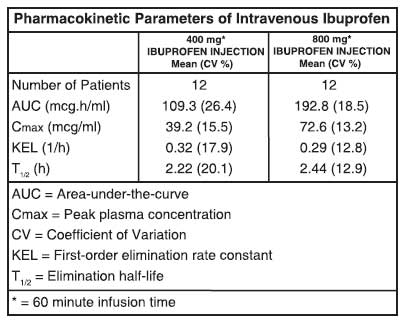
Ibuprofen, like most NSAIDs, is highly protein bound (> 99 % bound at 20 mcg/ml). Protein binding is saturable, and at concentrations > 20 mcg/ml binding is nonlinear. Based on oral dosing data, there is an age- or fever-related change in volume of distribution for ibuprofen.
INDICATIONS :
Analgesia :
IBUPROFEN INJECTION is indicated in adults for the management of mild to moderate pain and the management of moderate to severe pain as an adjunct to opioid analgesics.
Antipyretic :
IBUPROFEN INJECTION is indicated for the reduction of fever in adults.
Use the lowest effective dose for the shortest duration consistent with individual patient treatment goals. After observing the response to initial therapy with IBUPROFEN INJECTION, the dose and frequency should be adjusted to suit an individual patient’s needs. Do not exceed 3200 mg total daily dose. To reduce the risk of renal adverse reactions, patients must be well hydrated prior to administration of IBUPROFEN INJECTION.
Analgesia :
Administer 400 mg to 800 mg intravenously every 6 hours as necessary. Infusion time must be no less than 30 minutes.
Antipyretic :
Administer 400 mg intravenously, followed by 400 mg every 4 to 6 hours or 100-200 mg every 4 hours as necessary. Infusion time must be no less than 30 minutes.
Preparation and Administration :
IBUPROFEN INJECTION must be diluted prior to intravenous infusion. Dilute to a final concentration of 4 mg/ml or less. Appropriate diluents include 0.9 % Sodium Chloride Injection USP (normal saline), 5 % Dextrose Injection USP (D5W), or Lactated Ringers Solution.
800 mg dose : Dilute 8 ml of IBUPROFEN INJECTION in not less than 200 ml of diluent.
400 mg dose : Dilute 4 ml of IBUPROFEN INJECTION in not less than 100 ml of diluent.
Diluted solutions are stable for up to 24 hours at ambient temperature (approximately 20 to 25°C) and room lighting. Infusion time must be not less than 30 minutes.
CONTRAINDICATIONS :
Hypersensitivity :
IBUPROFEN INJECTION is contraindicated in patients with known hypersensitivity (e.g., anaphylactic reactions and serious skin reactions) to Ibuprofen.
Asthma and Allergic Reactions :
IBUPROFEN INJECTION is contraindicated in patients who have experienced asthma, urticaria, or allergic-type reactions after taking aspirin or other NSAIDs. Severe, rarely fatal anaphylactic-like reactions to NSAIDs have been reported in such patients.
Coronary Artery Bypass Graft (CABG) :
IBUPROFEN INJECTION is contraindicated for the treatment of peri-operative pain in the setting of coronary artery bypass graft (CABG) surgery.
Pregnancy :
Teratogenic effects - Category C prior to 30 weeks gestation; Category D starting at 30 weeks gestation Starting at 30 weeks gestation, IBUPROFEN INJECTION, and other NSAIDs, should be avoided by pregnant women as premature closure of the ductus arteriosus in the foetus may occur. IBUPROFEN INJECTION can cause foetal harm when administered to a pregnant woman starting at 30 weeks gestation. There are no adequate, well-controlled studies in pregnant women. Prior to 30 weeks gestation, IBUPROFEN INJECTION should be used during pregnancy only if the potential benefit justifies the potential risk to the foetus. Reproductive studies conducted in rats and rabbits have not demonstrated evidence of developmental abnormalities.
Labor and Delivery :
The effects of IBUPROFEN INJECTION on labor and delivery in pregnant women are unknown. In rat studies, maternal exposure to NSAIDs, as with other drugs known to inhibit prostaglandin synthesis, increased the incidence of dystocia and delayed parturition, and decreased pup survival.
Nursing mothers :
It is not known whether this drug is excreted in human milk. Because many drugs are excreted in human milk and because of the potential for serious adverse reactions in nursing infants from IBUPROFEN INJECTION, a decision should be made whether to discontinue nursing or discontinue the drug, taking into account the importance of the drug to the mother.
Paediatric Use :
Safety and effectiveness of IBUPROFEN INJECTION for management of pain and reduction of fever has not been established in paediatric patients below the age of 17 years.
Geriatric Use :
Clinical studies of IBUPROFEN INJECTION did not include sufficient numbers of subjects aged 65 and over to determine whether they respond differently from younger subjects. Dose selection for an elderly patient should be cautious, usually starting at the low end of the dosing range, reflecting the greater frequency of decreased hepatic, renal, or cardiac function, and of concomitant disease or other drug therapy. Elderly patients are at increased risk for serious GI adverse events.
INTERACTIONS AND INCOMPATIBILITIES :
Aspirin :
When ibuprofen is administered with aspirin, ibuprofen’s protein binding is reduced, although the clearance of free ibuprofen is not altered. The clinical significance of this interaction is not known; however, as with other NSAIDs, concomitant administration of IBUPROFEN INJECTION and aspirin is not generally recommended because of the potential for increased adverse effects.
Anticoagulants :
The effects of warfarin and NSAIDs on GI bleeding are synergistic, such that the users of both drugs together have a higher risk of serious GI bleeding than users of either drug alone.
ACE Inhibitors :
NSAIDs may diminish the antihypertensive effect of ACE inhibitors. This interaction should be given consideration in patients taking NSAIDs concomitantly with ACE inhibitors.
Diuretics :
Clinical studies and post-marketing observations have shown that ibuprofen can reduce the natriuretic effects of furosemide and thiazides in some patients. This response has been attributed to inhibition of renal prostaglandin synthesis. During concomitant therapy with NSAIDs, observe patients closely for signs of renal failure, as well as to assure diuretic efficacy.
| STRENTH | PACK SIZE | PACKING |
|---|---|---|
| 100 mg/ml | 4 ml filled in 7.5 ml Vial | 1 VIal per Box |
| 100 mg/ml | 8 ml filled in 10 ml Vial | 1 VIal per Box |
Disclaimer : For the use of a Registered Medical Practitioner or a Hospital or a Institution only. Also it is not intended to be used by healthcare professionals or patients for the purpose of prescribing or administering these products. Questions regarding the complete and current content of product labeling / specification / presentation should be directed to SGPharma.

 Cardiovascular
Cardiovascular



